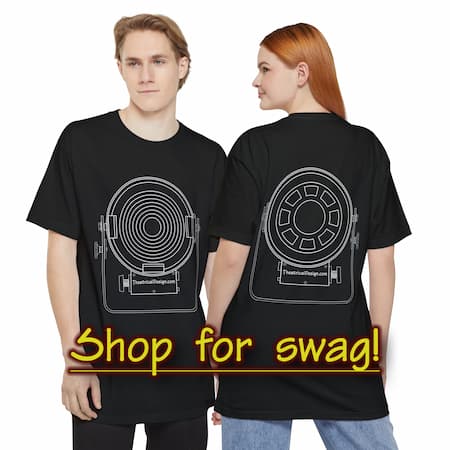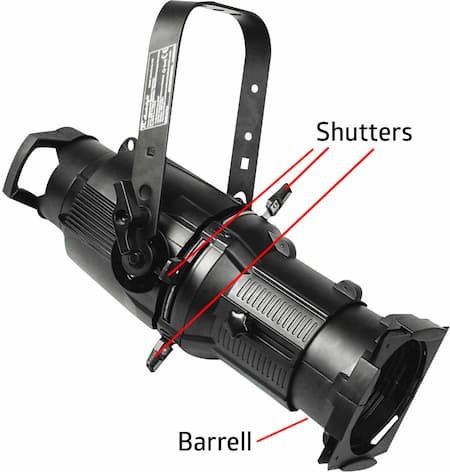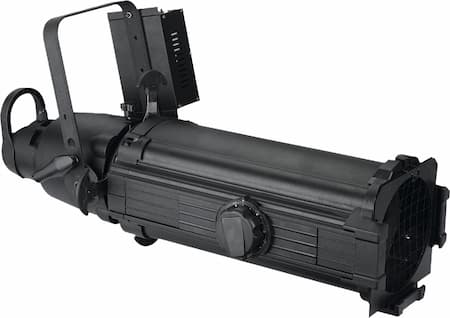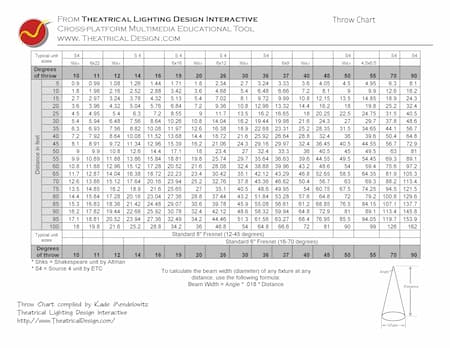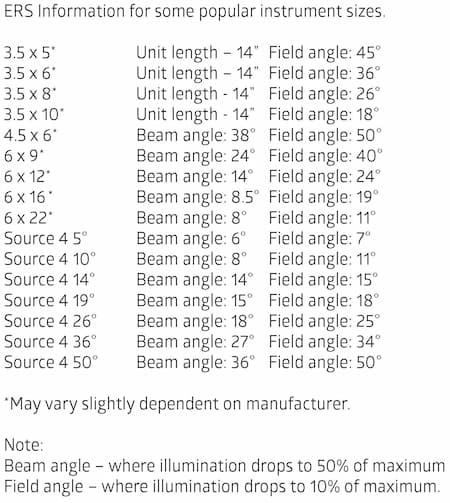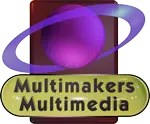Instruments
The leko (or ERS) is the most popular theatrical lighting instrument.
The leko is a favorite among lighting designers because of its flexibility. It can be adjusted to throw a clean (sharp, crisp) light or a fuzzier (softer) light. Due to its reflector and shutters, it can shape the light more than any other lighting instrument.
With the use of gobos (templates), the leko can throw a patterned light.
Leko Features video
Ellipsoidal Reflector Spotlights, or lekos, are the most flexible of the standard instruments in the theatrical lighting designer’s inventory.
When using the shutters on a leko, be aware that they function opposite to their placement. When the physical bottom shutter is pushed in, the top of the light is brought in.
Using a leko gives you the option of using a gobo or template. The gobo is inserted near the conjugate focal point in a slot by the top shutter. This template will allow a pattern of light to be projected. Many different patterns of gobos are available, and they can be special-ordered if needed.
In addition to a slot for patterns, some modern units offer the option of inserting an iris unit. Similar to a camera’s aperture, irises allow you to make the light smaller in a circular shape as compared to a straight shutter.
The lens tube on a leko is adjustable; this process of adjusting the lenses is called “running the barrel”. Running the barrel allows the light produced to have a sharp or soft edge. If using a gobo, you will be able to make the pattern crisp and clear, or fuzzy and diluted.
To produce an extremely sharp edge to the image or light, a donut may be inserted into the gel frame area. A donut needs to be made of a heat-resistant material, not a flammable substance like wood. The donut will eliminate the unfocused light, called highlation, and further clarify the pattern. Realize that using a donut will cause some of the light’s intensity to be lost.
On the occasion that the front of the unit is being exposed to the audience, you may wish to use a top hat. A top hat has a negligible effect on the thrown light of the unit, but it will serve to hide the lenses, and the source of the light from the audience. In addition, it also reduces unwanted glare.
Some modern units also allow you to rotate the housing of the unit, a capability that permits more specific shutter cuts and gives the designer better control over patterns projected by the unit.
A selection of modern ellipsoidal reflector spotlights allows you to adjust the lenses in the unit which affects the throw – or side of the light beam from the fixture. In this case, using an ETC Source 4, I can quickly change the lens casing, making the throw a wider 36 degrees, up from 19 degrees.
When using the shutters on a leko, be aware that they function opposite to their placement. When the physical bottom shutter is pushed in, the top of the light is brought in.
Using a leko gives you the option of using a gobo or template. The gobo is inserted near the conjugate focal point in a slot by the top shutter. This template will allow a pattern of light to be projected. Many different patterns of gobos are available, and they can be special-ordered if needed.
In addition to a slot for patterns, some modern units offer the option of inserting an iris unit. Similar to a camera’s aperture, irises allow you to make the light smaller in a circular shape as compared to a straight shutter.
The lens tube on a leko is adjustable; this process of adjusting the lenses is called “running the barrel”. Running the barrel allows the light produced to have a sharp or soft edge. If using a gobo, you will be able to make the pattern crisp and clear, or fuzzy and diluted.
To produce an extremely sharp edge to the image or light, a donut may be inserted into the gel frame area. A donut needs to be made of a heat-resistant material, not a flammable substance like wood. The donut will eliminate the unfocused light, called highlation, and further clarify the pattern. Realize that using a donut will cause some of the light’s intensity to be lost.
On the occasion that the front of the unit is being exposed to the audience, you may wish to use a top hat. A top hat has a negligible effect on the thrown light of the unit, but it will serve to hide the lenses, and the source of the light from the audience. In addition, it also reduces unwanted glare.
Some modern units also allow you to rotate the housing of the unit, a capability that permits more specific shutter cuts and gives the designer better control over patterns projected by the unit.
A selection of modern ellipsoidal reflector spotlights allows you to adjust the lenses in the unit which affects the throw – or side of the light beam from the fixture. In this case, using an ETC Source 4, I can quickly change the lens casing, making the throw a wider 36 degrees, up from 19 degrees.
Leko sizes are described by one of two methods.
- By size — diameter of lens x focal length. (ex: 6 x 9 indicated a 6” lens, 9” focal length)
- By throw–degree measurement of the cone of light thrown by the instrument. (ex: 10° equals 10 degree cone of light).

